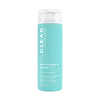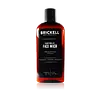What's inside
What's inside
 Benefits
Benefits

 Concerns
Concerns

 Ingredients Side-by-side
Ingredients Side-by-side

Salicylic Acid
MaskingWater
Skin ConditioningSodium Lauroyl Sarcosinate
CleansingAcrylates/Steareth-20 Methacrylate Copolymer
Glycerin
HumectantPEG-200 Hydrogenated Glyceryl Palmate
CleansingSodium Laureth Sulfate
CleansingArginine
MaskingButylene Glycol
HumectantPEG-7 Glyceryl Cocoate
EmulsifyingPanthenol
Skin ConditioningDisodium EDTA
Citric Acid
BufferingPEG-60 Hydrogenated Castor Oil
EmulsifyingSodium Citrate
BufferingPhenoxyethanol
PreservativeCaprylyl Glycol
EmollientChlorphenesin
AntimicrobialSalicylic Acid, Water, Sodium Lauroyl Sarcosinate, Acrylates/Steareth-20 Methacrylate Copolymer, Glycerin, PEG-200 Hydrogenated Glyceryl Palmate, Sodium Laureth Sulfate, Arginine, Butylene Glycol, PEG-7 Glyceryl Cocoate, Panthenol, Disodium EDTA, Citric Acid, PEG-60 Hydrogenated Castor Oil, Sodium Citrate, Phenoxyethanol, Caprylyl Glycol, Chlorphenesin
Aloe Barbadensis Leaf Juice
Skin ConditioningCentella Asiatica Extract
CleansingEquisetum Arvense Extract
AstringentPelargonium Graveolens Extract
MaskingTaraxacum Officinale Extract
Skin ConditioningSodium Methyl 2-Sulfolaurate
CleansingSodium Cocoyl Isethionate
CleansingCocamidopropyl Betaine
CleansingCocamidopropyl Hydroxysultaine
CleansingCoco-Glucoside
CleansingSodium Chloride
MaskingGlyceryl Oleate
EmollientSodium Benzoate
MaskingGuar Hydroxypropyltrimonium Chloride
Skin ConditioningTetrasodium Glutamate Diacetate
Decyl Glucoside
CleansingSodium Levulinate
Skin ConditioningCaprylhydroxamic Acid
Sodium PCA
HumectantCaprylyl Glycol
EmollientCitric Acid
BufferingGlycerin
HumectantEucalyptus Dives Leaf Oil
PerfumingMentha Piperita Oil
MaskingLemongrass Oil
Aloe Barbadensis Leaf Juice, Centella Asiatica Extract, Equisetum Arvense Extract, Pelargonium Graveolens Extract, Taraxacum Officinale Extract, Sodium Methyl 2-Sulfolaurate, Sodium Cocoyl Isethionate, Cocamidopropyl Betaine, Cocamidopropyl Hydroxysultaine, Coco-Glucoside, Sodium Chloride, Glyceryl Oleate, Sodium Benzoate, Guar Hydroxypropyltrimonium Chloride, Tetrasodium Glutamate Diacetate, Decyl Glucoside, Sodium Levulinate, Caprylhydroxamic Acid, Sodium PCA, Caprylyl Glycol, Citric Acid, Glycerin, Eucalyptus Dives Leaf Oil, Mentha Piperita Oil, Lemongrass Oil
 Reviews
Reviews

Ingredients Explained
These ingredients are found in both products.
Ingredients higher up in an ingredient list are typically present in a larger amount.
Caprylyl Glycol is a humectant and emollient, meaning it attracts and preserves moisture.
It is a common ingredient in many products, especially those designed to hydrate skin. The primary benefits are retaining moisture, skin softening, and promoting a healthy skin barrier.
Though Caprylyl Glycol is an alcohol derived from fatty acids, it is not the kind that can dry out skin.
This ingredient is also used as a preservative to extend the life of products. It has slight antimicrobial properties.
Learn more about Caprylyl GlycolCitric Acid is an alpha hydroxy acid (AHA) naturally found in citrus fruits like oranges, lemons, and limes.
Like other AHAs, citric acid can exfoliate skin by breaking down the bonds that hold dead skin cells together. This helps reveal smoother and brighter skin underneath.
However, this exfoliating effect only happens at high concentrations (20%) which can be hard to find in cosmetic products.
Due to this, citric acid is usually included in small amounts as a pH adjuster. This helps keep products slightly more acidic and compatible with skin's natural pH.
In skincare formulas, citric acid can:
While it can provide some skin benefits, research shows lactic acid and glycolic acid are generally more effective and less irritating exfoliants.
Most citric acid used in skincare today is made by fermenting sugars (usually from molasses). This synthetic version is identical to the natural citrus form but easier to stabilize and use in formulations.
Read more about some other popular AHA's here:
Learn more about Citric AcidGlycerin is already naturally found in your skin. It helps moisturize and protect your skin.
A study from 2016 found glycerin to be more effective as a humectant than AHAs and hyaluronic acid.
As a humectant, it helps the skin stay hydrated by pulling moisture to your skin. The low molecular weight of glycerin allows it to pull moisture into the deeper layers of your skin.
Hydrated skin improves your skin barrier; Your skin barrier helps protect against irritants and bacteria.
Glycerin has also been found to have antimicrobial and antiviral properties. Due to these properties, glycerin is often used in wound and burn treatments.
In cosmetics, glycerin is usually derived from plants such as soybean or palm. However, it can also be sourced from animals, such as tallow or animal fat.
This ingredient is organic, colorless, odorless, and non-toxic.
Glycerin is the name for this ingredient in American English. British English uses Glycerol/Glycerine.
Learn more about Glycerin